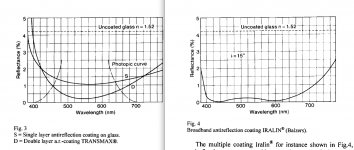Hello All,
In the next few days I’ll get my notes together and then post a new thread in the Swarovski forum about their anti-reflective coatings
But first to address a few points that have been raised:
A) the primary coating used on Swarovski products from 1948 to 1982 was a dual layer coating
It is commonly referred to as DV coating from the marking used on binoculars until 1962 (DV = doppel vergutung i.e. ‘double coated’)
B) single layer coating was only used on the Falke line of binoculars, and variations, from 1956 to 1968
The standard marking is EV, with a variant of V (EV = einfache vergutung i.e. ‘single coated’)
The coating was the first layer of the DV coating
C) multicoating - 3 layer coating - was first used on the AZF 30x75 drawtube telescope from it’s introduction in 1967 to 1983
The coating is known as Iralin and the name was prominently marked on the units. It was not used on any other products
D) and what we consider Swarovski’s modern multicoating - Swarotop - was generally introduced on all product lines in 1982
However, there were exceptions to D)
From around 1980 to the start of 1991, Swarovski used a more intense version of the DV coating, which was called Transmax, on both:
- the Traditional line of Porro prism binoculars
- and Metric pattern telescopic sights (Imperial pattern sight had Swarotop coating from their introduction in 1985)
ORIGINS
Both Swarovski’s dual layer coating, and it’s early multicoating, originated with the company Optics Balzers AG of Lichtenstein:
- in 1955, they commercially introduced ‘Transmax’, a dual layer anti-reflective coating
- and in 1965, they introduced ‘Iralin’, a broadband anti-reflective coating
See:
https://www.opticsbalzers.com/en/company/about-us/history.html
In addition, the name Transmax was also used in some early Swarovski advertising. See the attached text from a 1955 brochure
[ it’s from page 58 of Eine kurze Geschichte der Optik (‘A short History of Optics’) by Johannes Kern and Tea Barac, dated 2013
this is a thesis paper that was originally available on the web site of the College of Optometry at Hall Austria:
https://www.phtla-hall.tsn.at/content/allgemeines
It is currently available at:
https://www.yumpu.com/de/document/v...ichte-der-optik-private-htl-des-landes-tirol- ]
If one of our German speaking posters could provide a clear translation I’d be grateful
I transcribed the text, and put it through Google Translate but due to the technical language used the results were unsatisfactory
USE OF DV COATING
It seems to me that the point of using DV coating was that:
- it distinguished the products of Swarovski as a new optical company, from those of its rivals, especially the long established Zeiss and Leica
- in the immediate post-WWII period it was start-of-the-art technology, and
- it provided more transmission, though at the cost of a necessarily more tinted image
At the time, Swarovski seems to have concentrated primarily on the traditional European hunting market, rather than either the North American one,
or the emerging world wide birding market
I’ve attached a pair of diagrams that show the relative performance of single, DV and Iralin coatings
They are from pages 439 and 442 of Coatings on Glass by H.K. Pulker, which is available in various forms on the ‘net (Pulker was an Optics Balzers employee)
USE OF TRANSMAX IN THE 1980’s
Swarovski had introduced the SL series of Porro prism binoculars in 1980
Compared to the Traditional line of Porro prism binoculars, they featured:
- innovative design and production techniques
- fogproofing
- modern styling and materials
- and Swarotop coating (though I don’t think from the 1980 introduction, but within the first few years)
The use of Transmax may have been thought of as a way to further differentiate between the two Porro prism lines
However, the distinction was somewhat diminished, as Swarovski updated the Traditional line by:
- introducing the new fogproof model in 1984
- and then using Swarotop coating from 1991
I hope the above helps clarify some of the points raised in this thread
John






